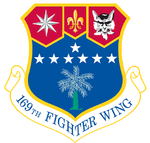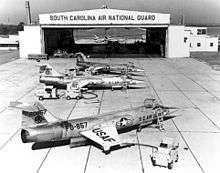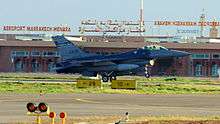169th Fighter Wing
| 169th Fighter Wing | |
|---|---|
|
157th Fighter Squadron Lockheed F-16C Block 52P Fighting Falcon 92-3909 equipped with 4x AIM-120 AMRAAM missiles. | |
| Active | 1957-Present |
| Country |
|
| Allegiance |
|
| Branch |
|
| Type | Squadron |
| Role | Tactical Fighter |
| Part of | South Carolina Air National Guard |
| Garrison/HQ | McEntire Joint National Guard Base, Eastover, South Carolina |
| Nickname(s) | Swamp Foxes |
| Tail Code | South Carolina |
| Insignia | |
| 169th Fighter Wing emblem |
 |
The 169th Fighter Wing (169 FW) is a unit of the South Carolina Air National Guard, stationed at McEntire Joint National Guard Base, Columbia, South Carolina. If activated to federal service, the Wing is gained by the United States Air Force Air Combat Command.
Overview
The federal mission of the 169 FW in accordance with Title 10 USC is to maintain wartime readiness and the ability to mobilize and deploy expeditiously to carry out tactical air missions or combat support activities in the event of a war or military emergency. More specifically, the wing specializes in the Suppression and Destruction of Enemy Air Defenses (SEAD). The SCANG operates as part of the Total Force of the U.S. military and is fully integrated with the active duty U.S. Air Force to perform its military mission.
The wing flies the F-16 Fighting Falcon, a single-seat, multipurpose fighter with the ability to fly at up to twice the speed of sound. It is capable of performing air-to-air and air-to-ground tactical missions. The 169th flew the F-16A from 1983 to 1994 and, in 1994, transitioned to the single seat F-16C Block 52 (and a small number of twin seat F-16D Block 52), also known as the F-16CJ, the newest, most advanced F-16 in the U.S. Air Force.
The SCANG's state mission under Title 32 USC is to respond to the call of the Governor of South Carolina in the event of natural disasters or domestic disturbances within the state of South Carolina.
About 900 of those personnel assigned to the SCANG are traditional Guard members who leave their full-time positions as civilian professionals, workers and students to train part-time with the Air National Guard. Approximately another 300 are federal employees serving as full-time Air Reserve Technicians (ART) at McEntire and drill with their respective Air Guard units, primarily those that are part of the 169 FW. Close to 50 South Carolina state employees also work at McEntire, some of whom also either active or retired members of the Air National Guard. An additional 150 active duty USAF personnel, both Regular Air Force and Active Guard and Reserve (AGR), round out the SCANG's Total Force fighter wing, as McEntire is home to the largest Active Associate program between the Regular Air Force and the Air National Guard in the nation's Combat Air Forces.[1]
Units
The 169th Fighter Wing consists of the following units:
- 169th Operations Group
- 157th Fighter Squadron (Block 52 F-16C/D Fighting Falcon)
- 169th Operations Support Flight
- 169th Maintenance Group
- 169th Mission Support Group
- 169th Medical Group
- 245th Air Traffic Control Squadron
- Det 1, 20th Operations Group
- Det 2, 20th Maintenance Operations Squadron
History

On 5 September 1957, the South Carolina Air National Guard 157th Fighter-Bomber Squadron was authorized to expand to a group level, and the 169th Fighter-Interceptor Group was established by the National Guard Bureau. The 157th was re-designated as a Fighter-Interceptor squadron and became the group's flying squadron. Other squadrons assigned into the group were the 169th Headquarters, 169th Material Squadron (Maintenance), 169th Combat Support Squadron, and the 169th USAF Dispensary.
Shortly afterwards Air Defense Command upgraded the new 169th FIG to the all-weather/day-night F-86L Sabre Interceptor aircraft, and in 1960, the 157th was one of three selected ANG units to receive F-104A Starfighter Mach-2 interceptors from the ADC active-duty interceptor forces. The "Swamp Foxes", as a result of the national recognition as one of the best air defense units in the nation, were chosen to fly the new high performance jet fighter.
Brigadier General Barnie B. McEntire, Jr., the first commander of the South Carolina ANG and its first general officer died 25 May 1961, when he courageously piloted his malfunctioning F-104 fighter jet away from populated areas near Harrisburg, Pennsylvania, to crash into the Susquehanna River. On 1 October 1961, then-Governor Ernest F. Hollings presided over the ceremony renaming the heroic wing commander's South Carolina installation from Congaree Air Base to McEntire Air National Guard Base.

The 169th FIG was called into active service a second time in November 1961 as the construction of the infamous "Berlin Wall" pushed the world to the brink of war. Within a month after mobilization, 750 personnel and 22 157th FIS F-104 aircraft were in place at Morón Air Base, Spain as the unit took up flying daily air defense patrols as part of the NATO air defense force in Western Europe. With world tension easing, the squadron returned home in August 1962.
In June 1963 the F-104s were transferred back to the active-duty Air Force and sent to Homestead AFB, Florida, where Air Defense Command was setting up a permanent presence after the Cuban Missile Crisis where the Starfighters would be better located for Air Defense against Soviet MiG fighters that were flown by the Cuban Air Force. The South Carolina ANG was re-equipped with the F-102A Delta Dagger, which was being replaced in the active duty interceptor force by the F-106. The Mach-2 "Deuce", still a very potent interceptor, served with the 169th FIG until April 1975, when Aerospace Defense Command was reducing the USAF interceptor force as the threat of Soviet Bombers attacking the United States was deemed remote.
Tactical Air Command

With the phase-down of continental air defenses in the 1970s, the 169th was transferred to Tactical Air Command (TAC), and was re-designated a Tactical Fighter Group. The 157th Tactical Fighter Squadron began to receive A-7D Corsair II subsonic tactical close air support aircraft from Tactical Air Command units that were preparing to receive the new A-10 Thunderbolt II. Receiving its aircraft from the 354th TFW at Myrtle Beach AFB and the 355th TFW at Davis-Monthan AFB, Arizona. The aircraft had excellent accuracy with the aid of an automatic electronic navigation and weapons delivery system. Although designed primarily as a ground attack aircraft, it also had limited air-to-air combat capability. In 1982, the 157th received new twin-seat A-7K trainers.

In the early 1980s, the South Carolina congressional delegation in Congress, led by Senators Strom Thurmond and Ernest Hollings, pressured the Department of Defense to upgrade Army and Air National Guard units with front line equipment to better supplement the Active Duty forces as part of the "Total Force" concept. Specifically, Thurmond and Hollings wanted the Air Force to equip the South Carolina ANG with the new F-16 Fighting Falcon, which was, as the time, just being introduced into the active duty force of Tactical Air Command. Beginning in July 1983, some of the initial Block 1 and Block 5 F-16As were transferred to the 169th Tactical Fighter Group, being the first Air National Guard unit to receive the aircraft. Its A-7Ds were subsequently reassigned to other Air National Guard units. Later, Block 10 F-16A/B were delivered by the Air Force to the 157th TFS. By the mid eighties all the F-16s received by the 169th had undergone Pacer Loft modification bringing them up to the same block 10 standard.
With the equipment change to the F-16, the 169th was assigned to the air defense mission again under Air Defense, Tactical Air Command (ADTAC), which was established when TAC assumed the Aerospace Defense Command mission in 1979. In addition, although the F-16s weren't adapted to perform in the tactical close air support mission that the A-7D was utilized for, the 157th TFS did practice the conventional attack role with Mark 82 (Mk 82) and Mark 84 (Mk 84) gliding bombs. The quality of the pilots and ammunition/maintenance crews of the 157th TFS was demonstrated during Gunsmoke '89 held at Nellis AFB from October 1 till October 14. The 157th TFS took first place out of 15 other teams.
In December 1990, during the buildup for war during Operation Desert Shield, the 157th was federalized for a third time and was deployed to Prince Sultan Air Base, Al Kharj, Saudi Arabia just a year and a half after taking first place at Gunsmoke '89. The 157th Tactical Fighter Squadron (Provisional) flew a total of 1,729 combat sorties during Operation Desert Storm. A total mission rate of over 90% was achieved, which was quite a remarkable feat.
Post Cold War era

Early in the 1990s with the declared end of the Cold War and the continued decline in military budgets, the Air Force restructured to meet changes in strategic requirements, decreasing personnel, and a smaller infrastructure. The 169th adopted the new USAF "Objective Organization" in early 1992, with the word "tactical" being eliminated from its designation and becoming the 169th Fighter Group. Tactical Air Command was inactivated on 1 June, being replaced by the new Air Combat Command (ACC).
In 1995, the 157th Fighter Squadron became the recipient of brand-new block 52 F-16C/D Fighting Falcons coming straight from the Lockheed facility at Fort Worth, Texas. The 162d Fighter Group becoming the first Air National Guard unit to receive these state-of-the-art aircraft. The mission profile of the unit changed in the way that they became a multi-role squadron being able to perform all kind of missions. More specifically they also received the HARM Targeting System being able to fly anti-radar sorties with the AGM-88 anti-radar missile.

The main mission profile of the squadron therefore changed to that of Suppression of Enemy Air Defenses (SEAD). The 157th Fighter Squadron continues to fly the SEAD mission today. Also, on 11 October 1995 ACC and the National Guard Board authorized expanding the status of the 162d to the Wing level, and the 157th Fighter Squadron became part of the new 162d Operations Group under the new 162d Fighter Wing.
In mid-1996, the Air Force, in response to budget cuts, and changing world situations, began experimenting with Air Expeditionary organizations. The Air Expeditionary Force (AEF) concept was developed that would mix Active-Duty, Reserve and Air National Guard elements into a combined force. Instead of entire permanent units deploying as "Provisional" as in the 1991 Gulf War, Expeditionary units are composed of "aviation packages" from several wings, including active-duty Air Force, the Air Force Reserve Command and the Air National Guard, would be married together to carry out the assigned deployment rotation.
In February 1997, the 157th Expeditionary Fighter Squadron (157 EFS) was first formed from 162d FW personnel and aircraft and deployed to Doha International Airport, Qatar, to join with other active-duty and national guard squadrons as part of Operation Southern Watch. This mission was initiated mainly to cover for attacks of Iraqi forces on the Iraqi Shi’ite Muslims. This made the 169th the first Air National Guard unit to deploy alongside active-duty Air Force units to comprise an Air Expeditionary Force (AEF).
The 157th EFS was activated again in January 2000 as a component of Operation Northern Watch; a United States European Command Combined Task Force (CTF) who was responsible for enforcing the United Nations mandated no-fly zone above the 36th parallel in Iraq. This mission was a successor to Operation Provide Comfort, which also entailed support for the Iraqi Kurds. The deployment was completed in April 2000. The 157th EFS was formed again in March 2001, when the unit deployed to Prince Sultan AB, Saudi Arabia in a second Operation Southern Watch deployment. The guardsmen returned to McIntire JGB in July.
Global War on Terrorism

In 2002, aircraft and personnel from the 169th deployed to Southwest Asia in support of Operation Enduring Freedom (OEF) and participated directly in combat operations. Also that year, 50 South Carolina ANG airmen, then assigned to the 240th Combat Communications Squadron, deployed to Central Asia for six months in support of the Global War on Terrorism, and the 245th ATCS deployed to Afghanistan in support of Operation Enduring Freedom.
In 2003, nearly 400 Airmen from the 169th and all its F-16s were mobilized and deployed to Southwest Asia as part of what became Operation Iraqi Freedom (OIF). The 169th was attached to the 379th Air Expeditionary Wing, stationed in Qatar, and flew more than 400 combat missions (performing the Suppression and Destruction of Enemy Air Defenses mission and flying numerous precision bombing missions over Iraq.

In 2005, the Base Realignment and Closure Commission announced an historic expansion at McEntire. Five more Block 52 F-16s from the active duty USAF would arrive at the base in 2006 and five more the following year. Then, in 2007, active duty Air Force personnel began arriving at McEntire as the base prepared to host and operate the largest Active Association unit in the nation's Combat Air Forces, bringing about 150 active duty personnel on board to work, train and deploy with the 169th.
In May 2010, the 169th became the first Air National Guard unit to support an AEF mission for a full 120 days. While simultaneously deploying Airmen for Operation Enduring Freedom, the wing deployed more than 300 Airmen in support of Operation Iraqi Freedom, during which the 169th flew more than 800 combat air patrol missions over Iraq from Balad AB and other locations. The unprecedented deployment also allowed the 169th team to escort the last Army combat forces out of Iraq on the last day of OEF.
Starting in October 2010 the 157th FS began an Air Sovereignty Alert mission at nearby Shaw AFB. The squadron has gradually taken over the duties of the 20th Fighter Wing. On 6 May 2011 the squadron completely took over the role when a new alert facility was built at McEntire Joint National Guard base.
Most recently, in April 2012, the 157th EFS was formed and deployed with pilots, maintenance specialists and support staffers. They provided air support to ground units from Kandahar Airfield, Afghanistan. Pilots flew more than 2,200 sorties for a total of 9,400 combat hours. The four-month deployment ended in late August.
Although not confirmed it has been discussed that the 157th Fighter Squadron will likely be re-equipped with the Lockheed Martin F-35A Lightning II early in its roll-out to active-duty USAF units as the South Carolina ANG has a history of receiving the newest equipment when it becomes available.
Lineage
- Designated: 169th Fighter-Interceptor Group, and allotted to South Carolina ANG, in 1957
- Extended federal recognition on 5 September 1957
- Re-designated: 169th Tactical Fighter Group, 1 Apr 1975
- Re-designated: 169th Fighter Group, 15 Mar 1992
- Status changed from Group to Wing, 11 October 1995
- Re-designated: 169th Fighter Wing, 11 October 1995
Assignments
- South Carolina Air National Guard, 9 September 1957 – Present
- Gained by: Montgomery Air Defense Sector, Air Defense Command
- Gained by: 35th Air Division, Air Defense Command, 1 April 1966
- Gained by: 35th Air Division, Aerospace Defense Command, 15 January 1968
- Gained by: 20th Air Division, Air Defense Command, 1 January 1970
- Gained by: Tactical Air Command, 1 April 1975
- Elements attached to: 4th Tactical Fighter Wing (Provisional), 29 December 1990-22 July 1991
- Gained by: Air Combat Command, 1 June 1992-Present
Components
- 169th Operations Group, 11 October 1995 – Present
- 157th Fighter-Interceptor (later Tactical Fighter, Fighter) Squadron, 5 September 1957 – Present
Stations
- Congaree Air Base (later McEntire Air National Guard Base), Columbia, South Carolina, 5 September 1957 – Present
- Designated: McEntire Joint National Guard Base, 1991
South Carolina Air National Guard deployments
|
|
Aircraft
|
|
Decorations
References
![]() This article incorporates public domain material from websites or documents of the Air Force Historical Research Agency.
This article incorporates public domain material from websites or documents of the Air Force Historical Research Agency.
- 169th Fighter Wing history website
- 169th Fighter Wing@globalsecurity.org
- Rogers, B. (2006). United States Air Force Unit Designations Since 1978. ISBN 1-85780-197-0
- Cornett, Lloyd H. and Johnson, Mildred W., A Handbook of Aerospace Defense Organization 1946 - 1980, Office of History, Aerospace Defense Center, Peterson AFB, CO (1980).
External links
| ||||||||||||||||||||||||||||||||||||||||||||||||||||||||||||||||||||||||||||||||||||||||||||||||||||||||||||||||||||||||||||||||||||||||||||||||||||||||||||||||||||||||||||||||||||||||||||||||||||||||||||||||||||||||||||||||||||||||||
| |||||||||||||||||||||||||||||||||||||||||||||||


